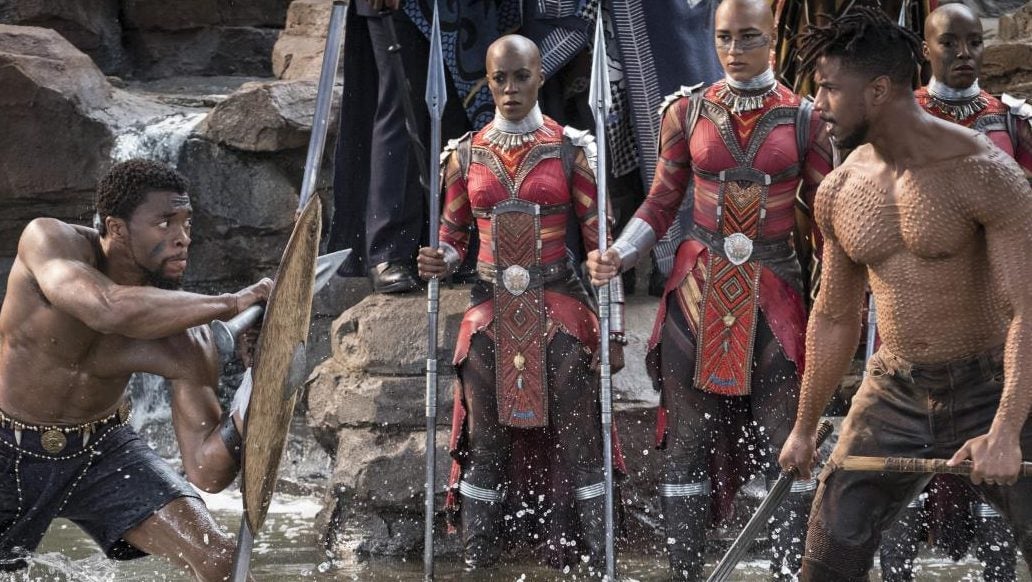“Black Panther” elevates the entire Marvel universe
It’s become something of a cliché to say a film (or television series) has good “world-building.” Often, it’s actually a backhanded compliment, meant to imply that while the setting a film’s characters and story inhabit may be unique and convincingly realized, those characters and story fail to populate it with anything interesting.


It’s become something of a cliché to say a film (or television series) has good “world-building.” Often, it’s actually a backhanded compliment, meant to imply that while the setting a film’s characters and story inhabit may be unique and convincingly realized, those characters and story fail to populate it with anything interesting.
Black Panther doesn’t have that problem. Unlike many other fantasy worlds, Wakanda, the fictional African kingdom where the Marvel film takes place, can’t be separated from the narrative. Wakanda—what it represents to different characters, what it is to outsiders, and what it should or shouldn’t be to the rest of the world—is the story of Black Panther. And it’s a great one.
An elaborate, mythic prologue—not unlike the one that introduces Peter Jackson’s The Lord of the Rings trilogy, sets the stage: Hundreds of years ago, a meteorite carrying the fictional alien metal vibranium crashed in Africa. Several tribes waged war over the powerful resource before they were eventually united under one banner by the first Black Panther, a man who had found a mysterious herb that granted him superhuman abilities. Using the metal, Wakanda became the most technologically advanced country in the world. But out of fear that they’d be colonized and exploited like much of the rest of the continent, the Wakandans shut themselves off from the world and use their technology to make the nation appear as though it’s destitute—thereby creating a hidden black oasis.
It’s an utterly fascinating mythology upon which to build a superhero story. Based on the comic book superhero of the same name, Black Panther follows T’Challa’s (Chadwick Boseman) ascendancy to the Wakandan throne following the death of his father, T’Chaka, who previously assumed the ceremonial mantle of the Black Panther. Like his father, T’Challa believes that Wakanda should remain isolated out of self-preservation, but there’s a growing sentiment within the Wakandan ranks that the country should open itself up to the world and share its technology and tradition.
The film really comes into its own when it introduces the villain: an American, Erik Killmonger (Michael B. Jordan) with a dark history and ties to Wakanda. Killmonger is by every measure the most interesting villain Marvel’s cinematic universe has ever offered. In fact, he’s only a “villain” insofar as his philosophy directly challenges that of our hero, the Black Panther. In large part due to a hugely committed performance by Jordan, Killmonger is a genuinely thrilling on-screen presence.
More than thrills, though, Killmonger inserts a profound moral dilemma into the heart of Black Panther, one steeped in racial history and identity that’s deeply personal to a large segment of the film’s audience. Killmonger—an Oakland, California native with special ops experience and a lifetime of righteous anger—advances a very different vision for Wakanda’s future from T’Challa’s. He wants to use the country’s massive vibranium reserves to arm black communities around the world so they can revolt against their oppressors. He wants a new world where he, and people who look like him, are finally in control of their destinies after centuries of subjugation.
If this doesn’t sound like an ordinary Marvel superhero film, that’s because it decidedly is not. It’s a testament to director Ryan Coogler’s vision that Black Panther is a wholly unique, self-sufficient film that still manages to fit snugly into the wider Marvel ecosystem. Marvel needs Black Panther much more than Black Panther needs Marvel, a set-up that is in some ways mirrored by the story. Does the world need Wakanda? Does the African diaspora need Wakanda? Or should Wakanda remain in defensive camouflage?
Coogler has created something original and vital out of a Disney-fied superhero universe that, for the most part, has operated at the same worn out wavelength for a decade. That’s a huge feat unto itself. Black Panther doesn’t “transcend” the superhero genre so much as it elevates the entire thing alongside it. It’s the most formidable Marvel film to date; a cinematic artifact that feels like it shouldn’t belong to the corporate superhero apparatus. But it’s really exciting to know that it does.